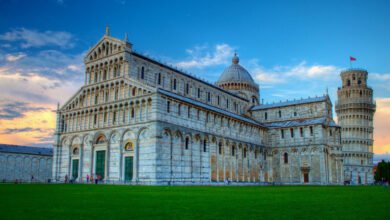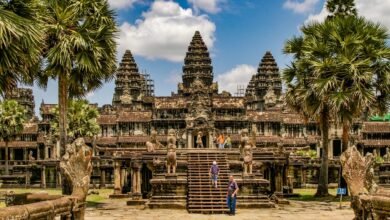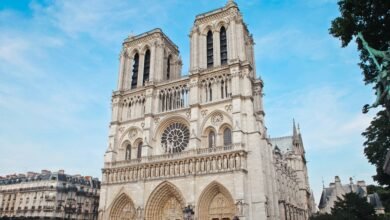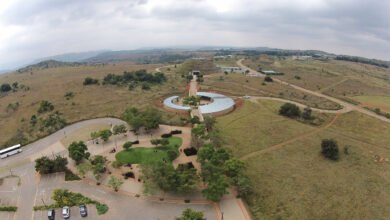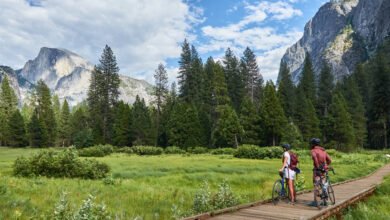Canyon de Chelly National Monument is more than just a preservation of towering sandstone walls, ancient rock art, or the stories of Native American cultures. Nestled graciously in the resplendent northeastern region of the illustrious U.S. state of Arizona, it is an extraordinary amalgamation of awe-inspiring geological wonders, rich human heritage, and breathtaking natural splendour.
The opulent National Monument, graciously established in 1931, sprawls across a vast expanse of over 83,840 acres, nestled within the illustrious boundaries of the esteemed Navajo Nation. This location remains one of North America’s longest continually inhabited landscapes. The Navajo people still inhabit and cultivate this land, which is replete with thousands of archaeological sites going back as far as 2500 B.C.
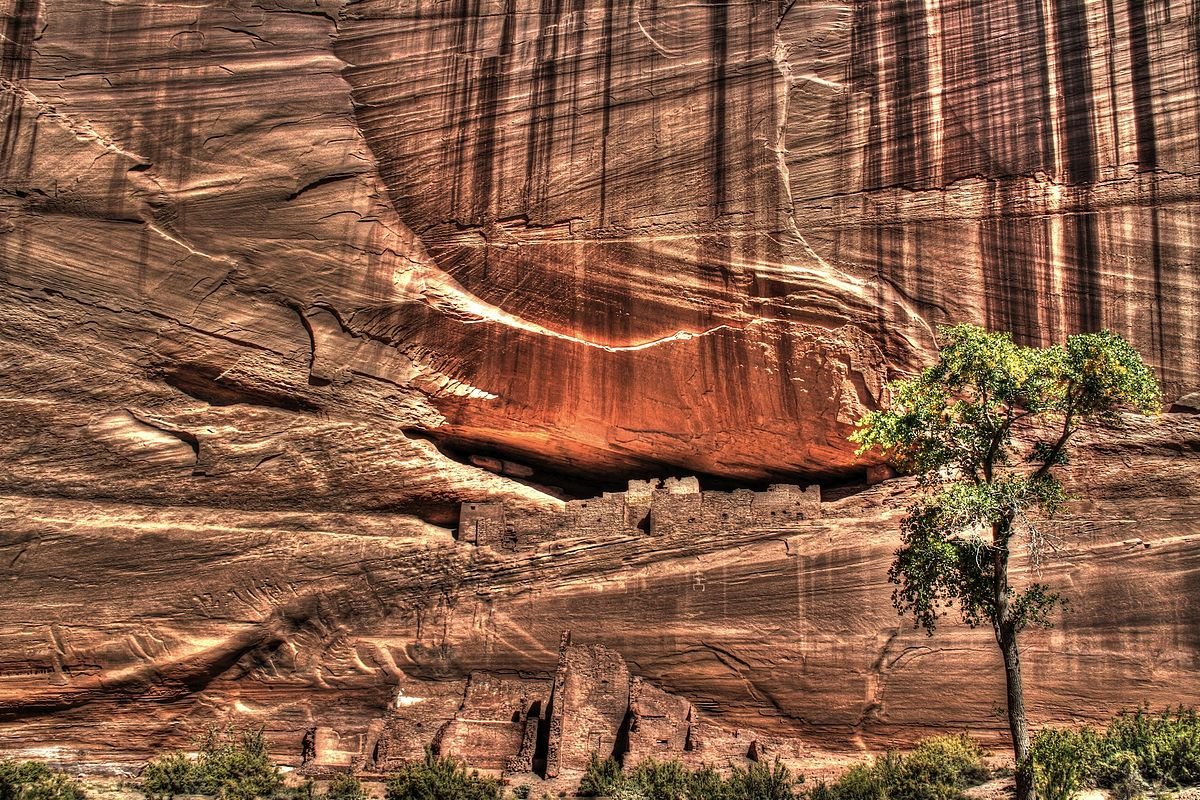
Echoes of the Ancient Past
The profound sense of history is palpable as you venture through the canyon’s paths. Petroglyphs and pictographs etched into the cliff walls provide a silent narrative of the Ancient Puebloans who once thrived here. The cliff dwellings known as “White House Ruins,” dating back to 1200 AD, are a poignant testament to this land’s early inhabitants.
Another must-see artefact of time is the “Mummy Cave,” named for the remains found there during an archaeological expedition. This site showcases a breathtaking, well-preserved cliff dwelling that is as visually captivating as historically significant.
Breathtaking Beauty and Natural Diversity
The natural beauty of Canyon de Chelly is simply awe-inspiring. The splendid red sandstone cliffs majestically ascend from the canyon’s depths, soaring to awe-inspiring altitudes surpassing 1,000 feet. The mesmerizing interplay of luminosity and obscurity, gracefully choreographed by the passage of time, bestows upon the landscape an ethereal metamorphosis, rendering it a perpetually evolving masterpiece. These resplendent tableaus, meticulously crafted by the hand of nature, ensnare the hearts of both discerning photographers and ardent admirers of the natural world. Moreover, the Canyon de Chelly National Monument has diverse flora and fauna. Cottonwood and willow trees provide a splash of green against the red canyon walls. At the same time, myriad creatures – including coyotes, foxes, deer, and various bird species – lend the area a vibrant, wild character.
Adventurous Explorations of Canyon de Chelly National Monument
Adventure awaits around every corner of Canyon de Chelly National Monument. The National Monument offers a variety of trails for visitors of all physical capabilities. For instance, the White House Ruin Trail is a 2.5-mile round-trip hike that allows explorers to experience the canyon from within.
Additionally, several scenic overlooks are accessible by car along the North and South Rim Drives, each offering a unique perspective on the magnificent formations below. Jeep tours, led by authorized Navajo guides, are also available for those who want a more in-depth exploration of the canyons, combined with captivating narrations of the land’s history and legends.
Respect and Coexistence
Canyon de Chelly National Monument is unique among U.S. national parks in that it is wholly contained within a Navajo Tribal Trust Land and is home to roughly 40 Navajo families. This blend of national monuments and residential areas necessitates a respectful coexistence between visitors and residents. When visiting, it’s important to remember that you’re a guest in a living community with a deeply-rooted heritage.
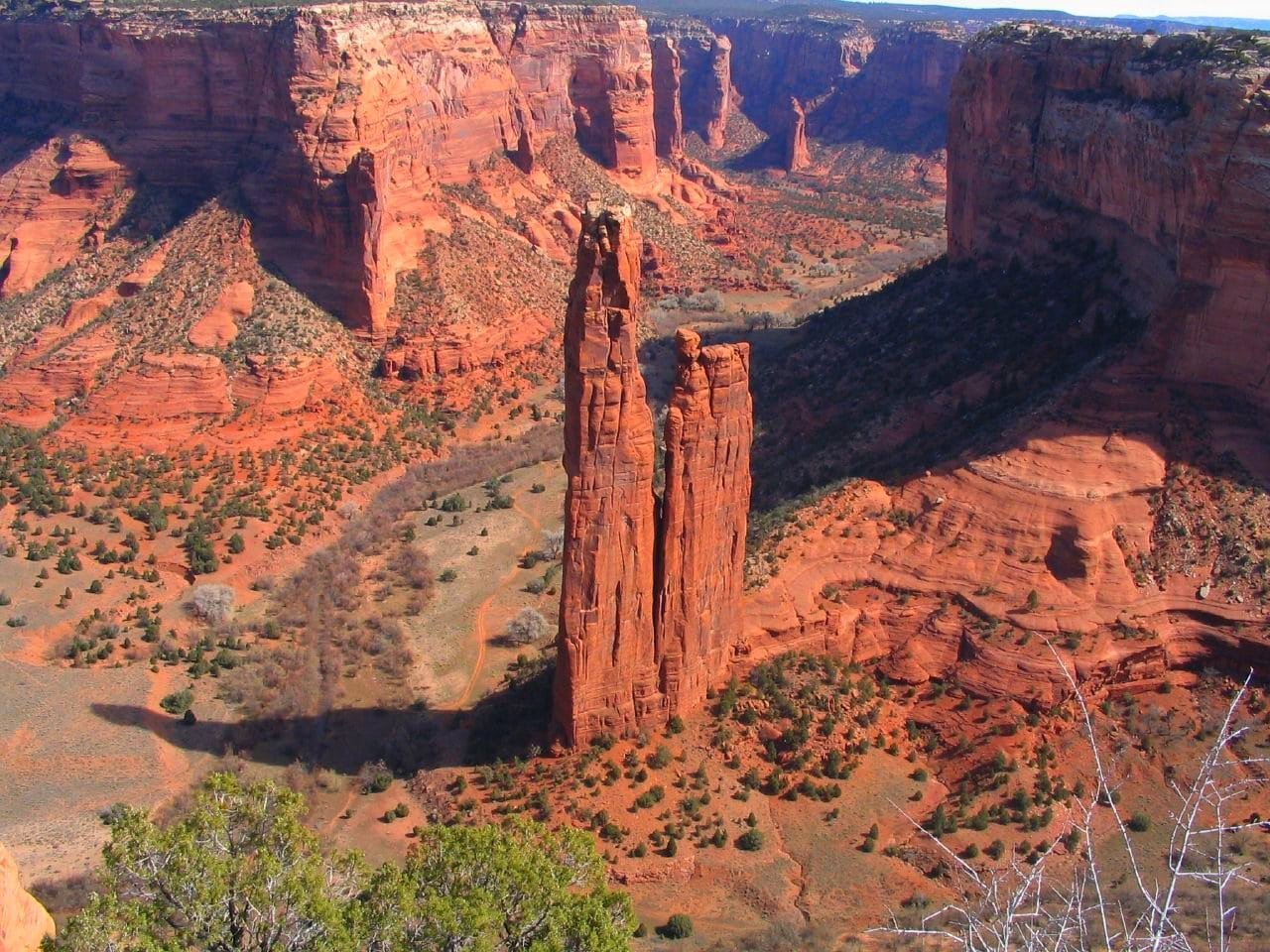
A Glimpse into Navajo Culture
Visiting Canyon de Chelly National Monument is a worthwhile experience. Also, an incredible opportunity to immerse oneself in Navajo culture. Navajo families have been shepherding sheep, farming lands, and living in the canyon for generations. This land is imbued with their history, stories, and spiritual beliefs, and welcoming presence imbues the MonumentMonument with a sense of living history.
It is an exclusive chance for guests to gain knowledge. Navajo traditions, folklore, and way of life through guided tours led by local Navajo guides. These narratives offer an extraordinary, in-depth understanding of the history, customs, and spiritual beliefs that have shaped this society for centuries.
Photography: Capturing the Wonder
Amateur and professional photographers are drawn to Canyon de Chelly National Monument for its surreal beauty and ever-changing light. From the deep reds of the sandstone cliffs to the verdant greens of the cottonwood trees to the striking blues of the Arizona sky, the canyon offers a kaleidoscope of colours that change with the passing hours and seasons.
There are numerous vantage points to capture stunning vistas, dramatic sunsets, or the stark play of shadows and light on the canyon walls. It’s a landscape photographer’s dream, where every hour brings a new perspective and a chance to capture something unique.
Stargazing: A Gateway to the Cosmos
The isolation of the Canyon de Chelly National Monument from light pollution makes it a fantastic stargazing site. The night unveils a celestial spectacle as the dark sky is punctuated with countless stars, planets, and the radiant band of the Milky Way. Stargazing here is not just a feast for the eyes but a humbling experience that gives a profound sense of our place in the universe.
Ensuring a Sustainable Future
Preservation is a key aspect of Canyon de Chelly National Monument’s mission. Maintaining such a delicate equilibrium is a testament to the luxury of our endeavours – safeguarding the glorious allure of nature’s grandeur and the abundant treasures of archaeology while simultaneously honouring the esteemed rights and traditions of the illustrious Navajo people, all while graciously accommodating an ever-expanding multitude of esteemed visitors.
Both the esteemed National Park Service and the illustrious Navajo Nation are ceaselessly endeavouring to guarantee that forthcoming generations can luxuriate in the opulence of this unparalleled sanctuary. When gracing the presence of this exquisite destination, one shall graciously contribute to these noble endeavours by faithfully adhering to the opulent guidelines, reverently respecting the meticulously designated trails, and elegantly practising the esteemed “Leave No Trace” principles.
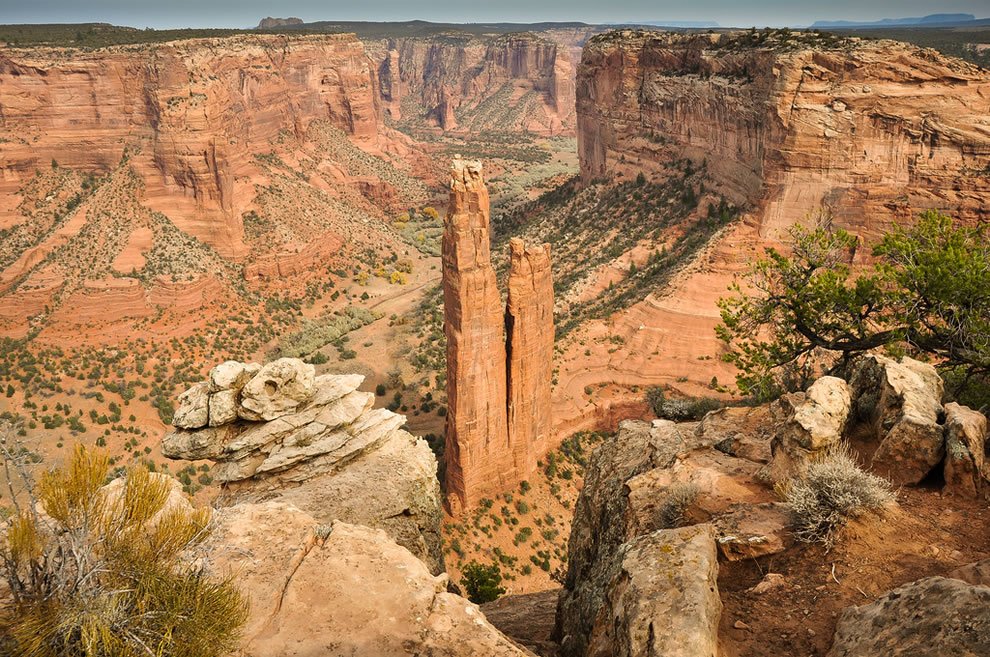
Final Thoughts
Canyon de Chelly National Monument is a testament to the intricate dance between nature and human existence. Its grandeur extends beyond the soaring cliffs and the remarkable ancient ruins. It also lies in the perseverance of culture, the stories told and retold over millennia, and the sacred bond between the Navajo people and their ancestral land.
Whether you’re there for a day or a week, the experience of Canyon de Chelly stays with you, quietly reminding you of nature’s enduring beauty and humanity’s indomitable spirit. To visit is to participate in an ongoing narrative that spans thousands of years and continues to unfold even today.
Seasonal Delights: A Year-Round Attraction
What’s wonderful about Canyon de Chelly National Monument is that it holds different delights throughout the year. Each season casts a new light on the park’s beauty and offers unique opportunities to engage with the environment.
The area awakens from its winter slumber in spring, filling the air with a fresh, crisp fragrance and temperate weather. This is an excellent time for hikes, as temperatures are moderate, and the flora begins to bloom.
The summer months bring longer days, allowing for extended park exploration. This is also the season for thunderstorms which, while requiring extra caution, can offer the dramatic sight of storm clouds rolling in over the cliff tops and the occasional rainbow arcing across the sky.
Autumn transforms the canyon into a stunning canvas of colour. The cottonwood trees lining the canyon floor turn a brilliant gold, creating a stunning contrast against the red cliffs and the azure skies. The fall season also offers cooler temperatures, making outdoor activities more comfortable.
Winter in Canyon de Chelly National Monument is a season of quiet beauty. Snow dusting the towering red cliffs is a sight, creating a serene, almost otherworldly landscape. The colder months also mean fewer visitors, offering a more solitary and peaceful park exploration.
Accommodations and Amenities
Nestled close to the park’s entrance lies the opulent Cottonwood Campground, a haven for those seeking an extended vacation. The campgrounds are lavishly adorned with state-of-the-art grills, opulent restrooms, and abundant refreshing, crystal-clear potable water. Thunderbird Lodge, located within the park, offers full-service accommodations, including a cafeteria serving Native American and American fare.
Additionally, the town of Chinle, located adjacent to the MonumentMonument, offers a variety of lodging options, restaurants, and shops. It is an excellent base for those exploring the park over multiple days.
Accessibility: Ensuring Everyone Can Enjoy the Beauty
The National Park Service has made considerable efforts to ensure Canyon de Chelly National Monument is accessible to as many people as possible. Many overlooks are wheelchair accessible, and the South Rim Drive is particularly suited for visitors with mobility issues, offering breathtaking views directly from the car.
Final Word
Canyon de Chelly National Monument is more than just a national park; it is a living, breathing testament to centuries of civilization and a monument to the enduring spirit of the Navajo people. Whilst positioned gracefully at the precipice of Spider Rock Overlook, one’s eyes shall be captivated by the glorious sandstone pinnacle, exuding an air of grandeur. Alternatively, should one embark upon the enchanting trails that meander through the canyon floor, they shall find themselves immersed in a realm where the majesty of nature intertwines harmoniously with the tapestry of human heritage. It is an abundant encounter that resonates profoundly with all who grace its presence, bestowing upon them a lofty viewpoint of the world that is both humbling and exquisitely inspiring.
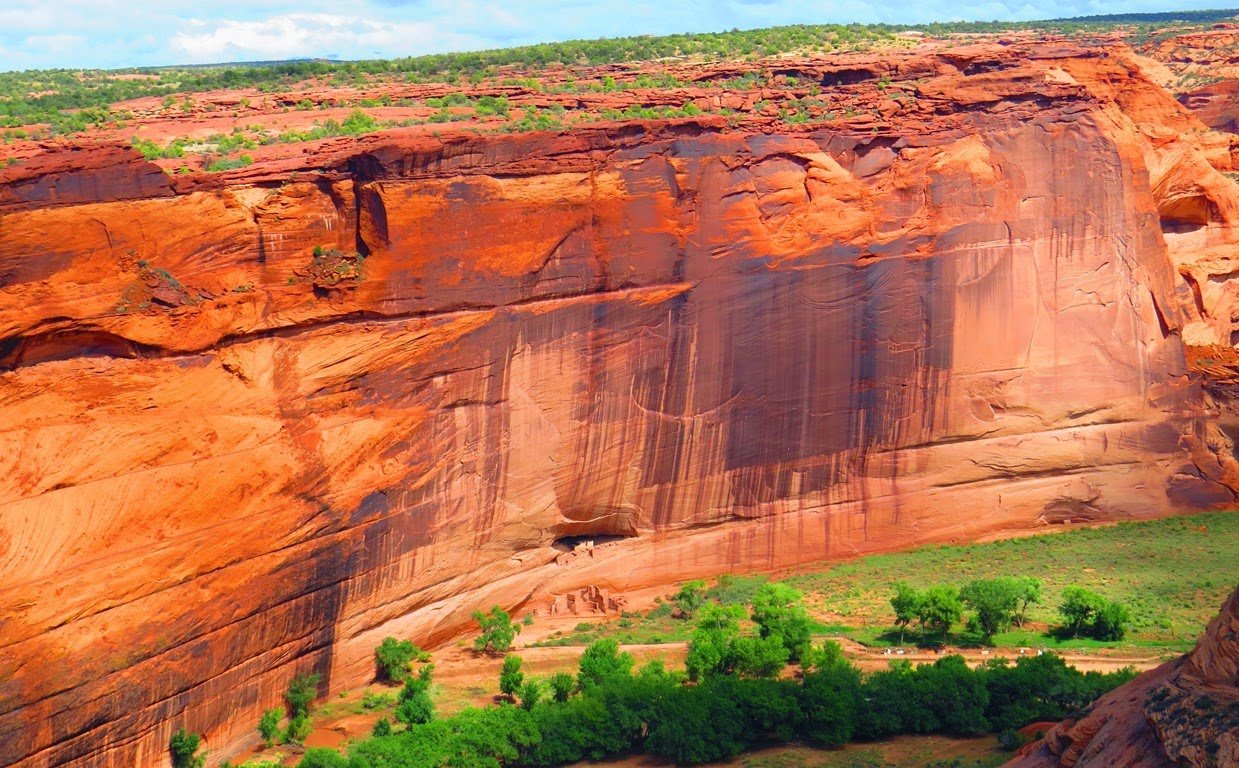
The Tales of the Rocks: Geology Unveiled
Canyon de Chelly’s geologic story is as layered and complex as the strata of its towering walls. The sandstone cliffs that define the MonumentMonument are composed of de Chelly Sandstone—a geological layer that dates back to the Permian Age, some 230 million years ago. These rocks owe their vibrant red hue to the iron oxide (or rust), which colours the sand grains.
Over millennia, natural forces, including wind, rain, and the freeze-thaw cycle, have sculpted these sandstone layers into the stunning cliffs, spires, and natural windows we see today. This continual process of erosion and weathering also reveals hidden treasures, such as petrified wood and dinosaur tracks, which are embedded in the rock layers. Each rock and formation tells a tale of the Earth’s ancient past.
The Power of Preservation: Archaeological Safeguards
One of the national monuments is the Canyon de Chelly National Monument. North America’s most significant archaeological preservations due to its wealth of artefacts and cliff dwellings. Preserving these invaluable resources is of the utmost significance.
The regal embrace of federal law protects all opulent archaeological sites decorated with petroglyphs and pictographs. Visitors, graced with the privilege of presence, are unequivocally forbidden from laying their hands upon these precious relics, altering their majestic essence, or even contemplating the audacious act of removing such treasures from their rightful place. By respecting these rules, visitors can help preserve the rich history for future generations to appreciate Canyon de Chelly.
Educational Opportunities: Learning Amidst Nature
Education is a crucial aspect of the Canyon de Chelly experience. Park rangers graciously extend their invitation to partake in opulent interpretive programs, meticulously crafted to bestow upon visitors a profound comprehension of the resplendent geological features, awe-inspiring archaeological sites, and the captivating narrative of the esteemed Navajo people. These opulent educational programs have been meticulously crafted to captivate and enlighten esteemed visitors of all ages. Explore geology, archaeology, and anthropology on a luxurious Canyon de Chelly expedition. This unique adventure takes you beyond the classroom to a real-world experience.
Closing Thoughts
As we journey through life, some places that touch us change our perspective and linger in our memories long after we leave. Canyon de Chelly National Monument is one such place. It becomes an epic journey through history, a wonderful celebration of tenacity, and a sumptuous exploration of awe-inspiring marvels and astounding human exploits.
Colourful sandstone cliffs captivate. Let the old tales gently carved into the rock’s fabric enchant you. Let the starry dome humble you, reminding you of nature’s grandeur and humanity’s core. Canyon de Chelly is a living witness to the fragile balance between nature and humanity. And in visiting, you become a part of its continuing story.
The Call of the Canyons: Introducing the Local Wildlife
The wildlife at Canyon de Chelly National Monument is as diverse and captivating as its geological formations. The MonumentMonument is home to many animal species, including mammals, birds, reptiles, and amphibians, each adding to the vibrant life force of this region.
Keep an eye out for coyotes, known in Navajo culture as cunning tricksters, or the red-tailed hawks soaring gracefully against the blue skies. Listen to the rustling of the Abert’s squirrel in the undergrowth or the haunting call of the Great Horned Owl echoing through the canyons at dusk. All these creatures play a crucial role in the canyon’s ecosystem, helping maintain its delicate balance.
Blending Art and Nature: The Artists in Residence Program
In recognition of the unique inspiration that Canyon de Chelly provides, the National Park Service runs an Artist in Residence Program. Artists worldwide are invited to stay in the park for a period, creating art inspired by the monumental landscape.
The resulting artworks—from painting and sculpture to music and poetry—capture the essence of Canyon de Chelly National Monument from diverse and fresh perspectives. This initiative further enriches visitors’ experience, offering them new ways to connect with the site.
The Mystique of Night: Guided Moonlight Walks
Canyon de Chelly National Monument offers a variety of guided walks, including a moonlight walk that should be noticed. Imagine traversing the paths with nothing but the light of the moon illuminating the towering sandstone cliffs and casting long, dancing shadows. It’s an otherworldly experience that invites contemplation and a deeper connection with the natural world.
Wrapping it Up: The Grandeur of Canyon de Chelly
From its profound historical and cultural significance to its breathtaking natural beauty, Canyon de Chelly National Monument offers visitors an immersive journey. Its rich tapestry of sights, sounds, and stories makes each visit a unique experience.
A visit to Canyon de Chelly National Monument is more than a journey through a beautiful landscape; it’s a journey through time and the narrative of human perseverance. As you walk its trails or gaze upon its ancient art, you’re not just observing; you’re participating in an ongoing story unfolding for thousands of years.
So, come to Canyon de Chelly National Monument. Explore, learn, reflect. Canyon de Chelly will leave an unforgettable mark on you, whether its breathtaking magnificence enthrals you, its people move you, or you are fascinated by its extensive history.
Human Impact: Footprints in the Sand
While Canyon de Chelly National Monument offers untold beauty and a rich tapestry of history and culture, it also tells a tale of human impact. It’s a story that can be read about the erosion of trails, the fading of ancient pictographs, and the disruption of wildlife.
Visitors can edit the story. We may limit our impact on this spectacular landscape by staying on pathways, avoiding sensitive areas, following “Leave No Trace” principles, and following park rules.
Responsible tourism isn’t just about preserving the park for future generations and respect and reciprocity. It’s about understanding that we are part of this landscape and that our actions ripple effects on the environment and the community that calls it home.
The Resilience of Nature: Signs of Regrowth
Despite the various challenges Canyon de Chelly National Monument faces, hope and resilience abound. Fire-ravaged areas are gradually re-greening, thanks to the hardy vegetation that has evolved to withstand such events. Endangered animal species are slowly returning, owing to rigorous conservation efforts.
Witnessing these signs of recovery and renewal instils a sense of optimism and reminds us of the tenacity of nature. It’s a compelling testament that nature can bounce back surprisingly with care, respect, and a bit of space.
Reflections: A Personal Encounter with Time and Eternity
As the sun dips below the canyon walls and the last rays of sunlight fade into twilight, a profound sense of peace descends on Canyon de Chelly National Monument. It’s a moment of quiet reflection where one can truly appreciate the timeless beauty of this remarkable place.
Canyon de Chelly National Monument is not just a site to visit; it’s a place to connect with—deeply and personally. Each rustling leaf, ancient petroglyph, and grain of wind-weathered sandstone tells a story waiting to be discovered. It’s an invitation to step outside your everyday life and into a narrative as old as time.
In Closing
Whether you’re drawn to the remarkable geological formations of the canyon, the intriguing echoes of ancient civilizations, the resilient and vibrant Navajo culture, or the simple tranquillity of the place, Canyon de Chelly National Monument holds a treasure for everyone.
In its canyons, we see the testament of time and the eternal dance between nature and humanity. In its silence, we hear the tales of civilizations past and the whisperings of the wind. In its vastness, we find a sense of connection—to the land, its history, and each other. And when we leave, we carry a piece of Canyon de Chelly National Monument with us—a memory, an insight, a sense of wonder long after our visit ends.
Adding A Personal Touch: Experiences from Visitors
Visitors often share stories of meaningful interactions with the Navajo people, enlightening moments of solitude amid the canyon’s vast expanse, and family memories created against this stunning natural beauty.
One visitor describes how a seemingly simple conversation with a Navajo guide blossomed into a profound exchange about native traditions and ways of life. Another recounts the spine-tingling moment when standing alone on the rim at sunrise, and they felt a deep connection with the land and a sense of peace they’d never experienced before. Families speak of the joy of seeing their children engage with nature, learn about a different culture, and understand the concept of preservation firsthand.
These personal narratives add another layer of richness to the Canyon de Chelly National Monument experience, making it not just a trip but a journey of discovery, connection, and personal growth.
Photography: Capturing the Moment
Canyon de Chelly National Monument is a photographer’s dream. From the first light of dawn illuminating the towering sandstone cliffs to the full moon casting an ethereal glow over the landscape, there are endless opportunities to capture stunning imagery.
Photography, however, is about more than just documenting the spectacle of the place. It’s also a powerful tool for telling the story of Canyon de Chelly National Monument, conveying its mood, rhythm, and spirit. Whether you’re a professional photographer or a casual enthusiast, you’ll find endless inspiration in this dramatic and ever-changing landscape.
Just remember: while capturing the beauty of Canyon de Chelly National Monument, respecting the privacy of the Navajo people and their homes is essential. Some areas are off-limits for photography, so always adhere to the regulations set by the park.
Safety: Navigating with Care
Safety is a vital consideration when visiting Canyon de Chelly National Monument. The park’s rugged terrain, extreme weather conditions, and isolated areas can pose risks if not appropriately managed.
Have enough drink, food, sunscreen, and clothes. This park has snakes and scorpions. Keep your distance, and never attempt to feed or touch wild animals.
A Final Note
This sentiment beautifully encapsulates the essence of Canyon de Chelly National Monument. In this place, the past, present, and future coexist, where every rock, every path, and every echo whispers the tales of times gone by and those yet to come.
As you explore the canyon’s depths or traverse the rim overlooking vast expanses, remember that you’re not just a visitor but a custodian—of the land, its stories, and its future. Carry this responsibility with care, and you’ll find that your trip to Canyon de Chelly National Monument becomes more than a journey through a national park; it becomes a journey through time, life, and the heart of the human spirit.
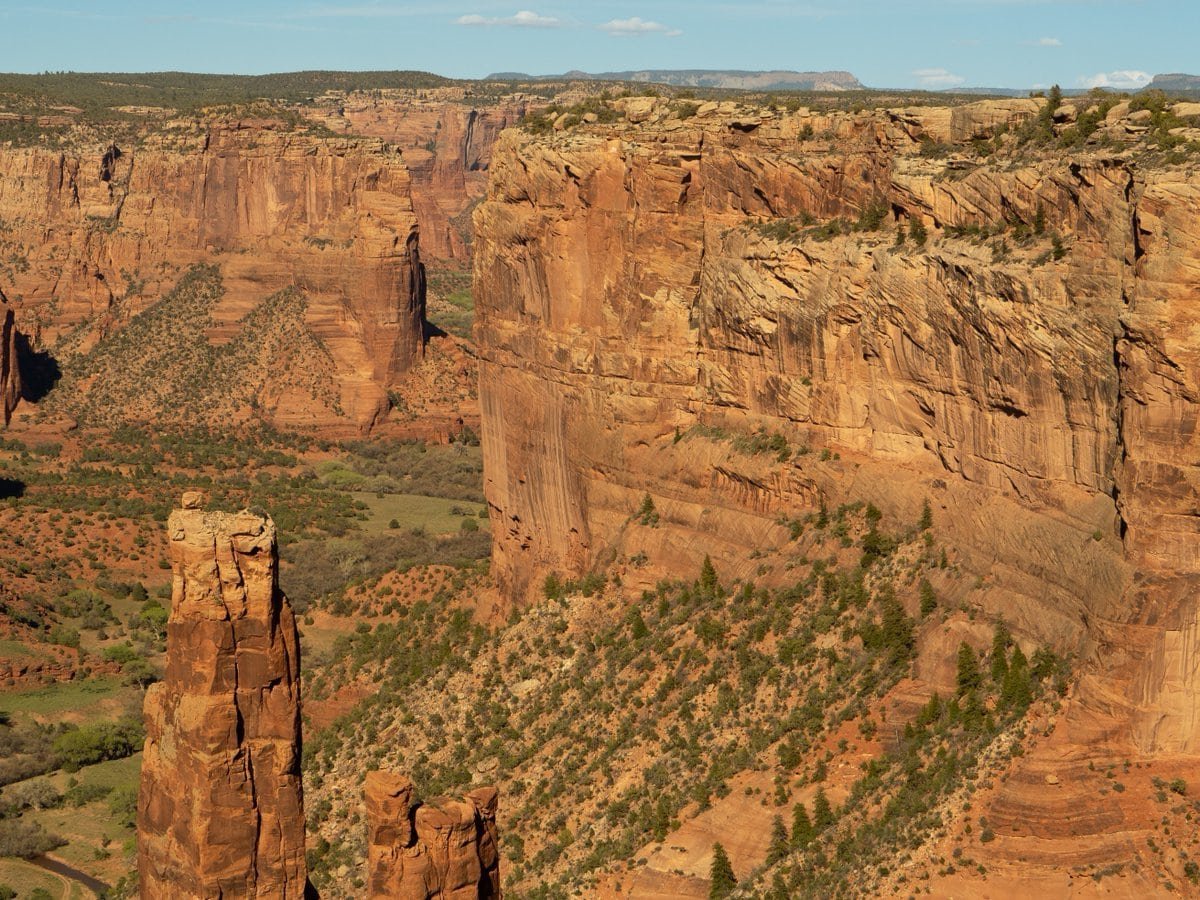
In Conclusion
Visiting Canyon de Chelly National Monument is more than just a sightseeing excursion. It’s an intimate encounter with timeless landscapes, a fascinating journey through history, and a tribute to the enduring spirit of the Native American cultures that have shaped, and continue to shape, this remarkable region. No matter how you explore Canyon de Chelly, the experience will likely resonate long after your trip ends.
FAQs (Frequently Asked Questions)
Q2: What makes Canyon de Chelly unique?
A2: Canyon de Chelly is unique due to its continuous habitation by Native peoples for nearly 5,000 years, its rich cultural heritage, stunning geological formations, and vibrant wildlife. The park also contains numerous historical and archaeological sites.
Q3: Can visitors explore Canyon de Chelly independently?
A3: While visitors can drive around the rim and stop at viewing points independently, exploring the canyon floor requires a permit and must be accompanied by a park ranger or authorized Navajo guide.
Q4: Are there any special activities or programs at the park?
A4: Yes, Canyon de Chelly offers a range of activities, including guided walks, educational programs, moonlight walks, and an Artist in Residence Program.
Q5: How can visitors contribute to the preservation of the monument?
A5: Visitors can contribute to preserving the monument by sticking to designated trails, practising "Leave No Trace" principles, respecting the park's rules and regulations, and not touching or removing artefacts.
Rate UsRate Us



